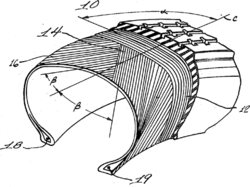Let's see if I can get this right... It's been a while since I took Physics...
The Ideal Gas Law is PV=nRT...
Note that n = Avogadro's Number, but since the same gas is used on both sides, it cancels out. (Actually, since the tires are initially filled with air, and the tank has CO2, it doesn't work this way, but I don't want to deal with that*, so I'm going to ignore it in a 'close enough' approach)
... and a derived combined gas law is:
(P1 V1) / T1 = (P2 V2) / T2 where:
P1 is tank pressure
V1 is tank volume
T1 is tank temp
P2 is tire pressure
V2 is tire volume
T2 is tire temp
So, as you can see, tire temp and tank temp are factors. Unless you can let your tires cool to the same temp as the tank. If you can do that then it simplifies to:
P1 V1 = P2 V2
For P1, subtract max tire pressure from starting tank pressure to get available tank pressure (i.e. you can't get 32 psi from a tank that only has 28 psi)
if you solve for P2:
P2 = (P1 V1) / V2
that will give you the total fill pressure available.
If you then divide that available fill pressure by the tire pressure difference per fill (i.e. 32 - 6?), that will tell you how many tires you can 'top off'.
Of course, if you divide that number by four, you will get how many times you can 'top off' all four tires...
Some other factors are involved (such as the fact that tires aren't rigid tanks), but this should get you close enough.
To get the tire volume, calculate the volume of a cylinder equivalent to the wheel/tire combo:
V1 = (tire height / 2) squared * width
Then you have to figure the volume of a cylinder the size of the rim:
V3 = (rim height / 2) squared * width
And subtract the two to get the tire volume (to be used above):
V2 = V1 - V2
Did I get it right?
* I'd rather shoot moles than calculate 'em.

